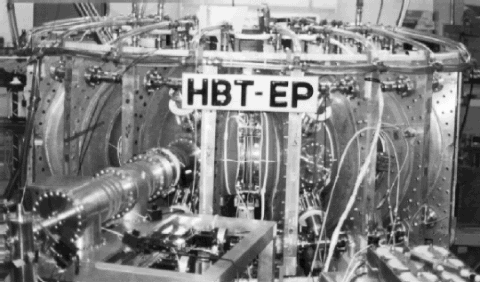
By Laurie Gertner
The HBT-EP, One of Columbia's Plasma Reactors
Last December, researchers at the National Tokamak Fusion Test Reactor (TFTR) in Princeton, NJ, reached a new record of fusion power output by using a Tritium-Deuterium fuel. Since then, experiments both by Princeton and Columbia researchers at this facility have made significant advances towards practical applications of fusion energy. Significant contributors include Applied Physics Professors Gerald Navratil and Mike Mauel, both of whom work at TFTR and the Morningside Heights campus, and Research Scientist Steven Sabbagh, who works solely at the Morningside Heights campus.
The fundamental problem of fusion is to give two nuclei enough kinetic energy to overcome their repulsive forces so that the nuclei would fuse together. Fusion can be achieved by heating the nuclei or "fuel" to extremely high temperatures, causing the nuclei to exist in plasma form, or a collection of electrons and ionized nuclei.
The ratio of the energy produced by fusion to the total energy input is an important parameter in a plasma reactor. At the point of break even, the released fusion energy equals energy input. At ignition, fusion reactions can maintain the temperature of the plasma without any additional input heating power. Another problem in fusion physics is confining the plasma. Both at TFTR in Princeton and at Morningside Heights, a toroidal container called a tokamak is used. A tokamak consists of two magnetic fields used to confine and stabilize the plasma. The strong toroidal field is produced by current in the windings of the toroid. The weaker poloidal field is produced by a current in the plasma. The sum of the two creates a helical field which prevents the plasma from touching the walls of the vacuum chamber inside the tokamak. The plasma at TFTR is heated by injecting a beam of energetic neutral particles into the plasma.
Most of the research at Columbia focuses on achieving a high ratio (beta) of the plasma pressure to magnetic field pressure. For every tokamak, there is a limit to this ratio. As the ratio increases, more power would be released. One way to increase this ratio is to change the plasma current profile, which also changes the shape of the plasma. At TFTR, the research is focused on "ramping down", or quickly decreasing the current in order to achieve a sharp change in the plasma current distribution. Although this effect is transient, it is important to study different effects which cause a change in the beta limit.
The research at the Morningside Heights campus is also focusing on the beta limit. Columbia's tokamak, which is smaller than TFTR, creates a deuterium plasma, but can not reach the temperatures high enough to cause fusion. Their work focuses on exploring different methods of using passive conductors (eddy currents) and externally applied fields (active control) to extend the beta limit.

From pg. 1+ of The Moment, 7 Dec. 1994